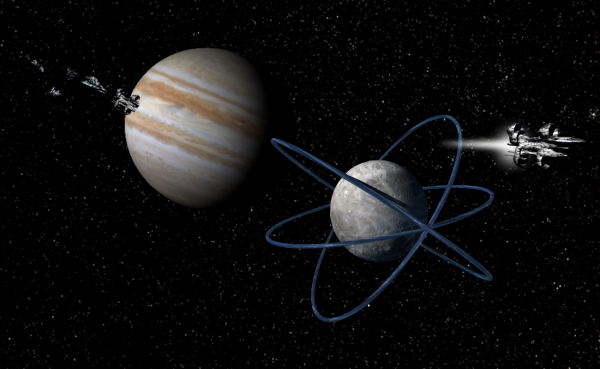BY LETTER
Ganymede
 Image from Steve Bowers | |
| Ganymede with its three angled orbital rings is a hub for interplanetary and interstellar traffic | |
Ganymede | |
| Type | EuEuropan |
|---|---|
| Primary, Position | Jupiter vii |
| Distance from Primary | 1,070,000 km |
| Satellites | None |
| Diameter and Gravity | 5,268 km / 0.145 G |
| Length of day and year | 7.155 days / 7.155 days (tidally locked) |
| Atmosphere | Minimal |
| Surface composition | Water Ice |
| Planetology | The largest of the Galileean Moons, Ganymede is a world larger than the planet Mercury. The icy surface was originally divided into dark regions mingled with younger brighter areas scoured by grooves and furrows with kilometer-high sides. Much of this has since been urbanised. |
Population: 45 billion sophonts (50% aquatic provolve (various), 20% Europan, 10% aquatic neogen, 10% vec (aquatic or cryo/vac-adapted), 5% Methanoid, 3% cryo/vac-adapted cyborg, 2% all others).
The aquatic population of Ganymede is, if anything, even more diverse than that of Europa. Ganymedian aquatic sophonts (usually gengineered or bodymodded to live under the local conditions of cold water, low light, and high pressure) include Acties, Brain Kelp, Eudore, Kanuma, Madi, Streyas, several different octopoid clades, two different merpeople clades, five different Panthalassan xenoprovolve clades (including a large Lignosagittiae conclave), and a large community of the Envome clade known as the Gently Waving Fronds in a Friendly Current.
Distinctly different from Europa is the much more heavily populated lunar surface (total population ~ 9 billion), consisting mostly of cryovecs, Methanoids, and cryoborgs, plus the rare near-baseline human or other sophont who chooses to make their home here.
Government: Ganymede has no formal government. The overall society operates as a meritocratic adhocracy, in which the sophont(s) deemed most competent in a given subject at a given moment is automatically considered the leader when dealing with issues relating to that subject. In practice, this is managed by a combination of extensive public profiles maintained on each individual in the local network (including their education, interests, skills, and demonstrated accomplishments and capabilities as observed by the community angelnet) and a network of Project Managers (chosen by random lot from the general population, flash educated by specially designed knowledge grafts and skill modules, and assigned terms of service ranging from a few days to a few months), who work to ensure that all groups, teams, collectives, organizations, etc. that may form operate as smoothly and amiably as possible.
Planetary Surface: The interior ocean of Ganymede has been re-engineered into a moon-spanning multi-level ecosystem very much like that of Europa. Conversion-Fusion hybrid reactors arranged in a three-dimensional grid throughout the ocean volume generate heat, light, and synthesized heavy elements which are harvested by specialized neumanns, processed, and excreted as the organic compounds which form the basis for the entire ecosystem. The primary difference between the Europan and Ganymedean world oceans is that the waters of Ganymeded are considerably warmer and more brightly lit (comparatively speaking) and that a signficant fraction of the heavy elements created by the hybrid reactors are pumped to the surface to support the mechosystem there.
The surface of Ganymede is home to a cryobot-based mechosystem, which in turn supports a large population of cryovecs of the Metasoft Forming School. These artistic machines spend much of their time carving nests out of the ice, and covering the surface with their sculptures and art. They share their world with several hundred Methanoid habitats, and collaborate with them on the development of low-temperature neogens for fun and profit. Of particular note are the jointly built arcologies, carved entirely (and elaborately) out of ice and pressurised with methane to act as comfortable Tweak homes. A number of cryoborgs also make their home on Ganymede's surface, including a temple of Cold Monks from the Sophic League. Vast fields of nanotech-based "plants" cover much of Ganymede's surface, growing their stalks and seeds from rock and ice.
Orbital Space: Ganymede orbital space is one of the busiest locations in the Jovian system. Transys pods, interplanetary spacecraft, and the occasional interstellar vessel are all coming and going at any given time. To support this volume of orbital traffic, Ganymede is encircled by three orbital rings, one around the equator and two running at 45-degree angles to the equator. This arrangement allows ground-to-orbit beanstalks to be deployed across a large portion of the surface, not just at the equator. Connected by a maglev-based rapid transit system linking all three rings together and combining seamlessly with the wider Transys network, the rings of Ganymede allow fast and easy transport to any point in the Solar System or beyond.
History: Ganymede was the original capital of the Jovian League, and in the late Interplanetary Age the most populous of the Galilean moons. Most of the settlements were underground and heavily shielded from the Jovian radiation field.
Back to Solsys
Related Articles
Appears in Topics
Development Notes
Text by M. Alan Kazlev
Updated 6 November 2021 by Orion's Arm Editors
Initially published on 01 November 2001.
Updated 6 November 2021 by Orion's Arm Editors
Initially published on 01 November 2001.






